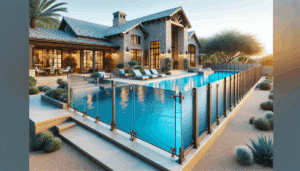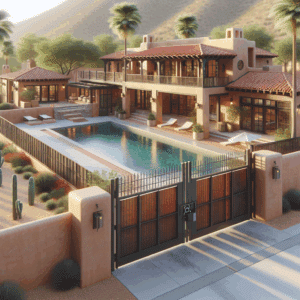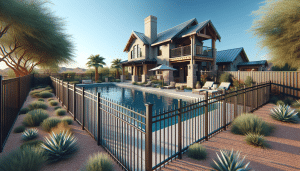Living in Mesa means your backyard pool is practically the center of your universe for about eight months out of the year. But if you have little ones running around or grandkids visiting, that sparkling water turns from a relaxing oasis into a major source of anxiety. The good news is you don’t have to sacrifice your backyard’s vibe just to keep everyone safe.
Contents
The Myth That Safety Has to Be Ugly
Let’s be real for a second. When most people hear “pool fence,” they immediately picture some bulky, industrial-looking barrier that ruins the flow of their patio. It used to be that way, honestly. You had to choose between a fortress that looked like a construction site or taking a risk with no barrier at all. But things have changed.
Modern removable pool fences are designed with transparency in mind. The goal isn’t just to block access; it’s to preserve your view. Whether you’re watching the kids swim or just enjoying the sunset hitting the Red Mountain, you want a barrier that fades into the background. It’s a balancing act between rigid safety standards and the aesthetic appeal of your outdoor living space.
Choosing the Right Mesh Color
Here is where things get a little counterintuitive. If you want a fence that “disappears,” your first instinct might be to pick white. It makes sense, right? White feels airy and light. But in reality, white mesh reflects the harsh Arizona sunlight, creating a wall of glare that is actually harder to see through.
If you want the fence to be as invisible as possible, black mesh is usually the way to go. It sounds weird, but think about window screens. They are almost always black because the eye focuses past the dark color rather than on it.
However, Mesa homes often have a very specific palette. We see a lot of stucco, sandstone pavers, and desert landscaping.
- Black Mesh: The best for transparency. It provides a sleek, modern look and allows for the best supervision of the pool area.
- Brown or Tan Mesh: These earth tones are fantastic if you want the hardware to match your surroundings. If your patio deck is beige or you have a lot of natural stone, a brown fence coordinates with the environment rather than contrasting against it.
- White or Light Colors: Generally, these are less transparent but might be necessary if strict HOA guidelines require them.
You know what? Sometimes the best choice is a combination. You might choose black mesh for the see-through quality but pair it with tan poles to match your deck. It’s all about what catches the eye—or rather, what doesn’t.
The Backbone: Pole Design and Material
The mesh gets all the attention because it’s what you see, but the poles are doing the heavy lifting. In our intense heat, materials matter. You don’t want something that becomes brittle after three summers of baking in 110-degree weather.
Most high-quality systems use aircraft-grade aluminum poles. Why aluminum? It doesn’t rust, which is a pretty big deal when it’s sitting next to chlorinated or salt water all day. Plus, it’s lightweight, making the “removable” part of the fence actually true.
There is also the question of reinforcement. You might hear terms like “tri-core” or “reinforced X-pole.” Without getting too bogged down in the engineering jargon, this just refers to the internal structure of the pole. A hollow tube is okay, but a tube with internal ribs is much stronger. This strength is crucial not just for preventing a child from pushing it over, but for maintaining that nice, tight tension that keeps the fence looking sharp and not saggy.
Layout: Following the Flow of Your Yard
This is where a lot of DIY attempts go wrong. You can have the nicest materials in the world, but if the layout feels cramped, you’re going to hate it.
Here’s the thing—you don’t always have to wrap the fence right up against the water’s edge. In fact, that often feels claustrophobic. If you have the space, it’s usually better to encompass the “wet deck” area or give yourself a few feet of walking room inside the fence.
Think about how you use the space. Do you have a BBQ grill that stays out year-round? You don’t want the fence cutting off access to the burger flipping station. A professional layout considers the “traffic flow” of your backyard.
Common Layout Styles
| Style | Description | Best For |
|---|---|---|
| Perimeter Loop | Follows the shape of the pool closely, usually 2-3 feet from the edge. | Smaller backyards where space is at a premium. |
| Patio Partition | Runs straight across the patio, separating the house from the pool area entirely. | Large covered patios; keeps the pool “out of sight, out of mind” for toddlers. |
| L-Shape or U-Shape | Utilizes existing block walls or house walls to close the gap. | Cost-effective solutions that use existing barriers. |
Note regarding existing walls: If you plan to use your house or a yard wall as the fourth side of the barrier, make sure any doors or gates leading to the pool area are self-closing and self-latching. A fence is only as good as its weakest link.
Height Matters: 48 vs. 60 Inches
In Mesa and throughout Arizona, the standard for pool safety barriers is typically 5 feet (60 inches) for perimeter fences, but when it comes to internal removable mesh fencing, you have a choice.
Most homeowners go with 48 inches (4 feet). It’s high enough that a toddler can’t climb over it, but low enough that an adult can easily see over it while standing on the patio. It feels less like a cage.
However, if you have particularly adventurous climbers or larger dogs that love the water, bumping up to a 5-foot height might be the smarter play. It adds an extra layer of security, though it does impose a bit more on the view.
The “Removable” Factor
Let’s talk about why you’re looking at this type of fencing in the first place. It’s removable. But how removable is it, really?
If you’re imagining taking it down every single morning and putting it back up every night, stop right there. That’s not how this works. It takes a bit of effort—usually about 10 to 15 minutes for an average-sized pool.
Most people leave the fence up 95% of the time. The “removable” feature shines when you’re hosting an adults-only dinner party, or maybe during those cooler winter months when the pool is closed and the kids aren’t playing outside as much.
When the fence is down, you’re left with small holes in your deck where the poles sat. These are covered with deck caps that match the color of your cool decking or pavers. You won’t trip over them, and they prevent dirt and debris from filling up the sleeves.
Customizing the Gate
The gate is the most important part of the system. It’s the entry point, and statistically, it’s where accidents are most likely to happen if someone forgets to close it.
You shouldn’t rely on a manual opening where you have to unhook a section of the fence to get in. That gets annoying fast, and human nature being what it is, you’ll eventually start leaving it unhooked “just for a second.”
A self-closing, self-latching gate is non-negotiable for true safety. These gates use magnetic latches (like the MagnaLatch) that are positioned high up, out of a child’s reach. They swing shut automatically and lock. From a design perspective, the gate usually matches the rest of the fence, but the frame is rigid to support the swinging mechanism. It looks clean, professional, and gives you that satisfying click when it closes.
Durability in the Desert
We briefly touched on the heat, but let’s dig a little deeper. The sun in Mesa is relentless. UV radiation destroys plastics and weak fabrics.
When you are shopping for a design, ask about the UV stabilizers in the mesh and the thread. Yes, even the thread holding the border on matters. If the thread rots after two years, the border falls off, and the fence looks terrible (and becomes unsafe).
High-quality mesh is interlocked, meaning if you were to poke a hole in it, the mesh wouldn’t unravel. It’s tough stuff. It can handle the monsoon storms, the haboobs, and the blazing July sun without fading into a weird, chalky grey color.
Bringing It All Together
At the end of the day, the right design is the one that gets used. If the fence is too ugly, you’ll resent it. If it’s too hard to use, you’ll leave it open. Finding that sweet spot between a fence that blends into your beautiful Mesa backyard and one that acts as a fortress for your children is easier than you think. It just takes a little planning and the right materials.
If you are ready to secure your pool without ruining your view, we can help you design the perfect layout for your home. Give Pool Safety Fencing a call today at 480-771-8026 to discuss your options, or Request A Free Quote online to get started on a safer, better-looking backyard.




